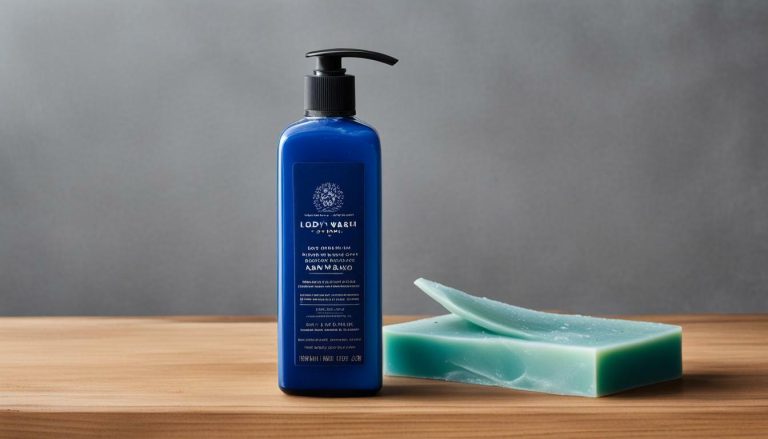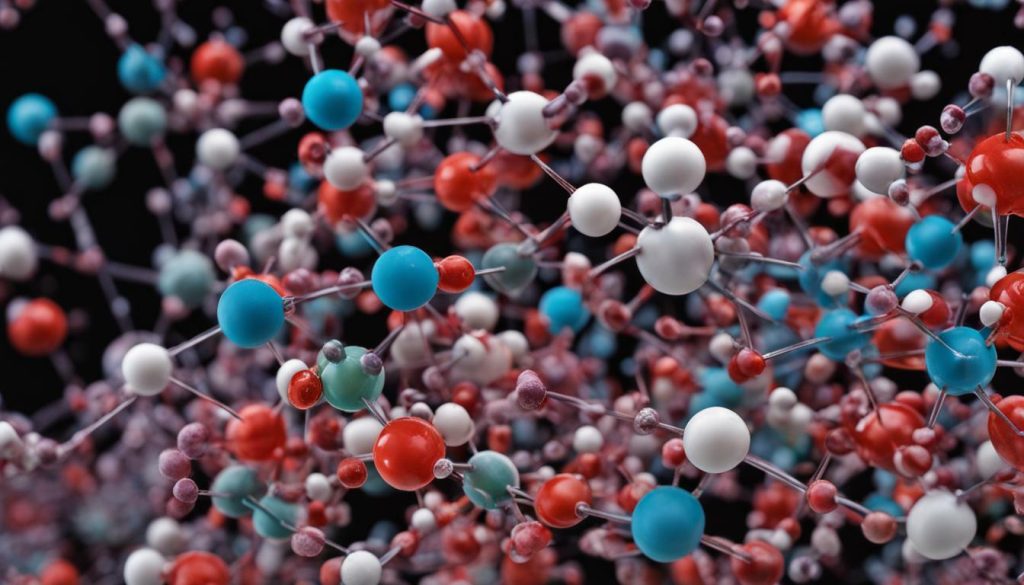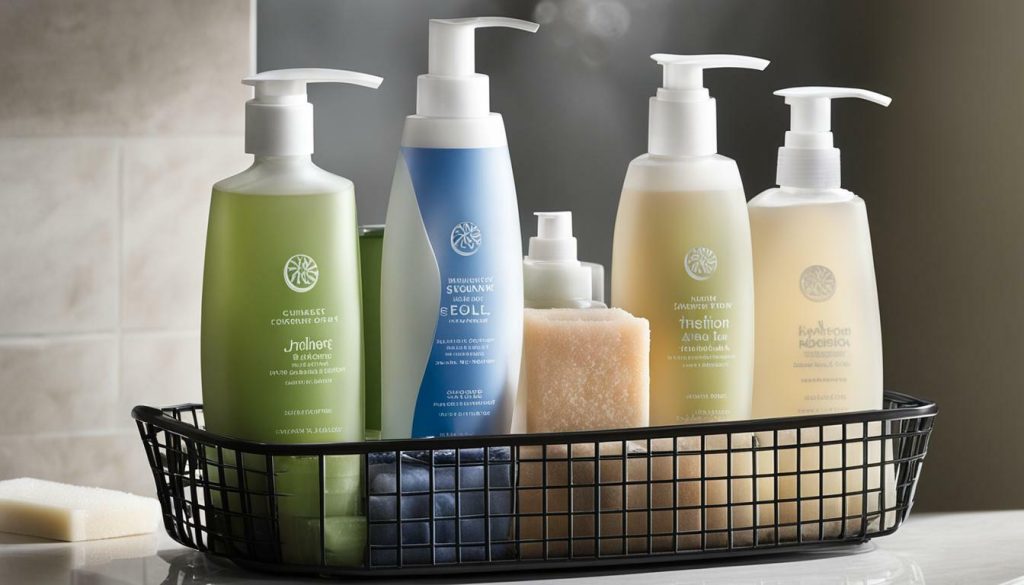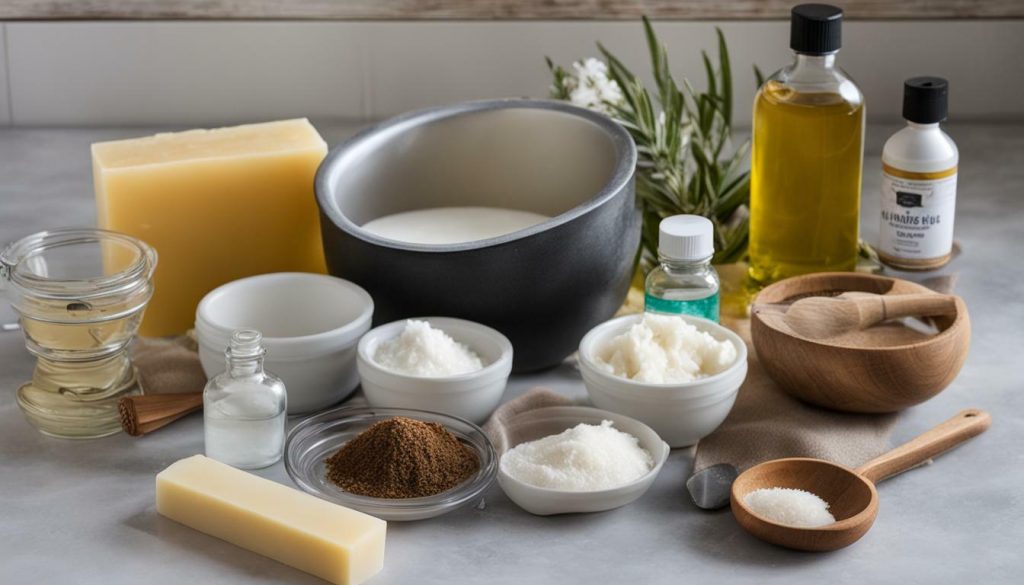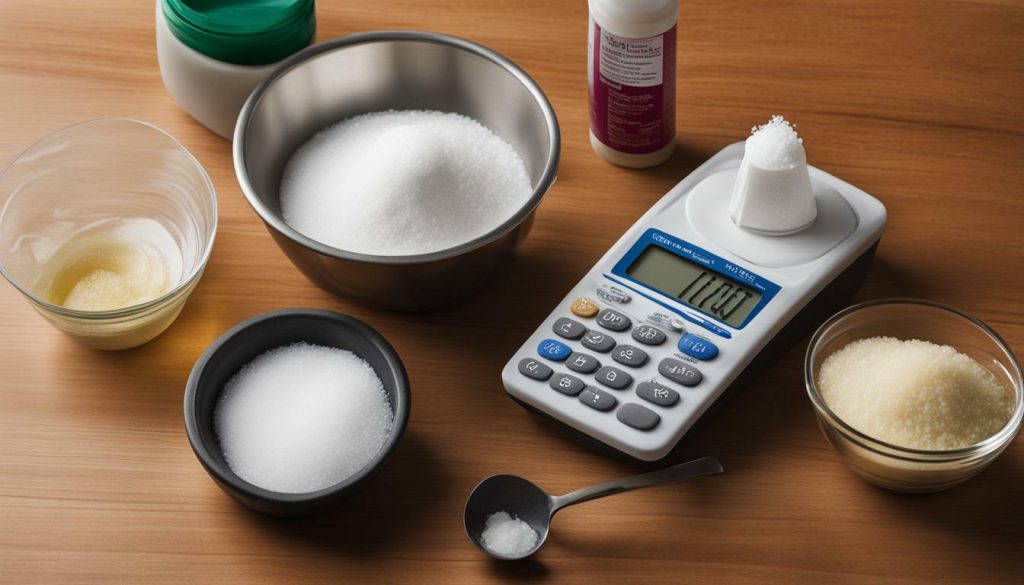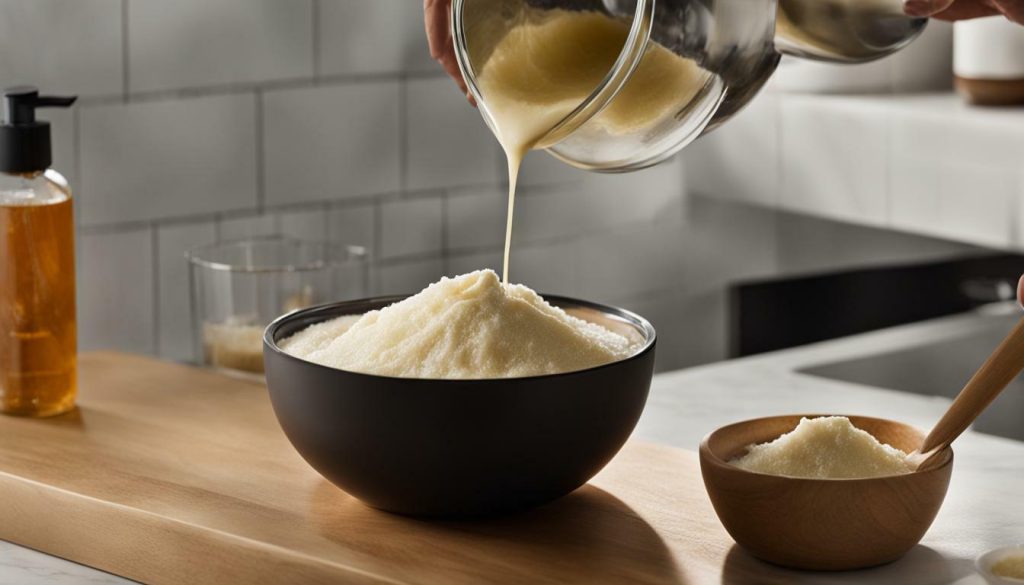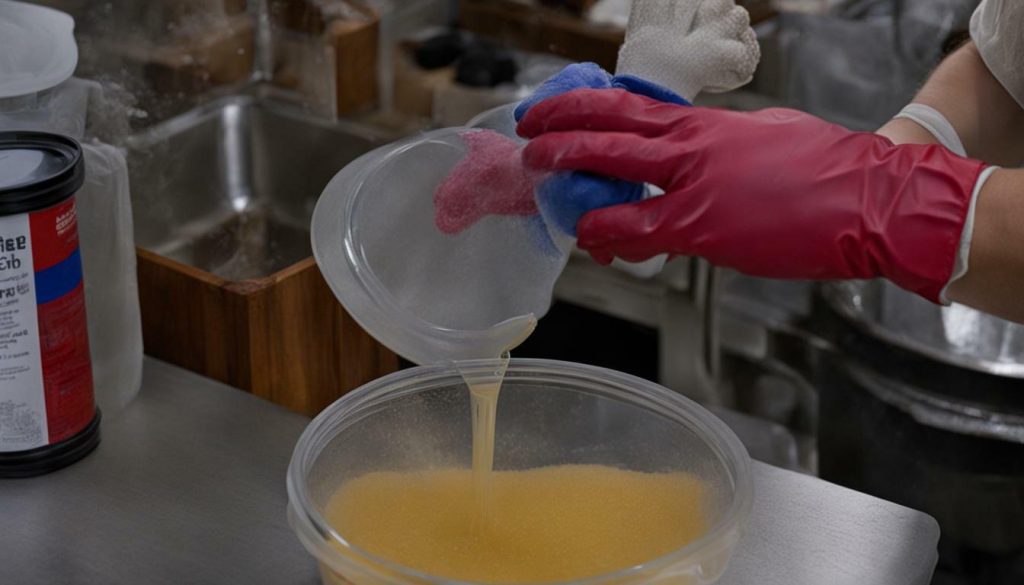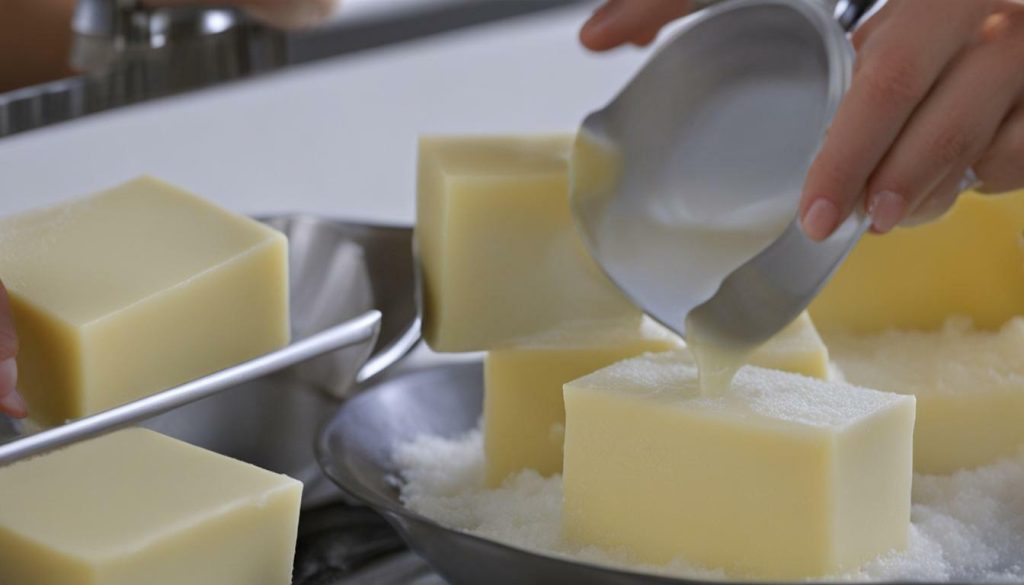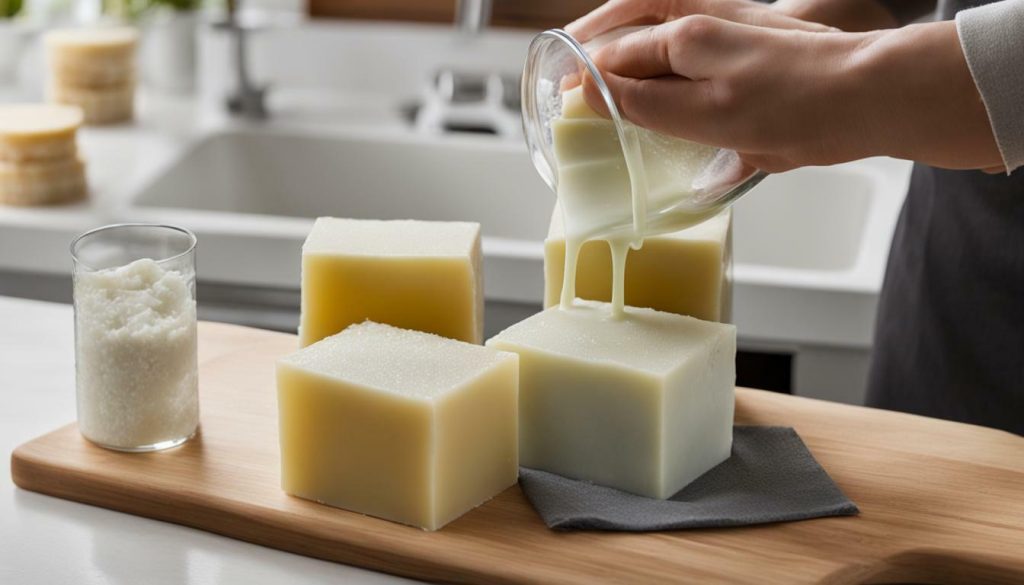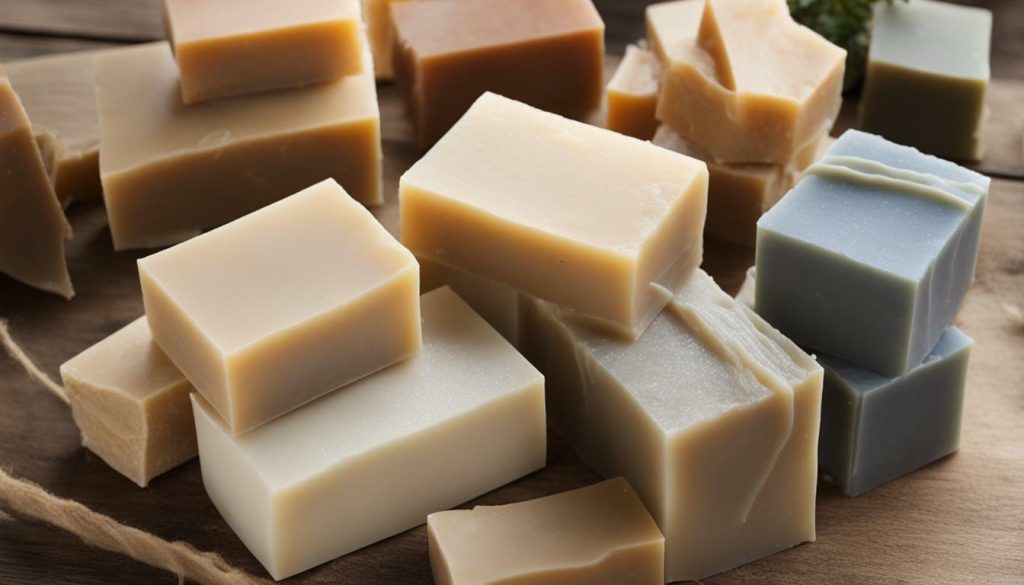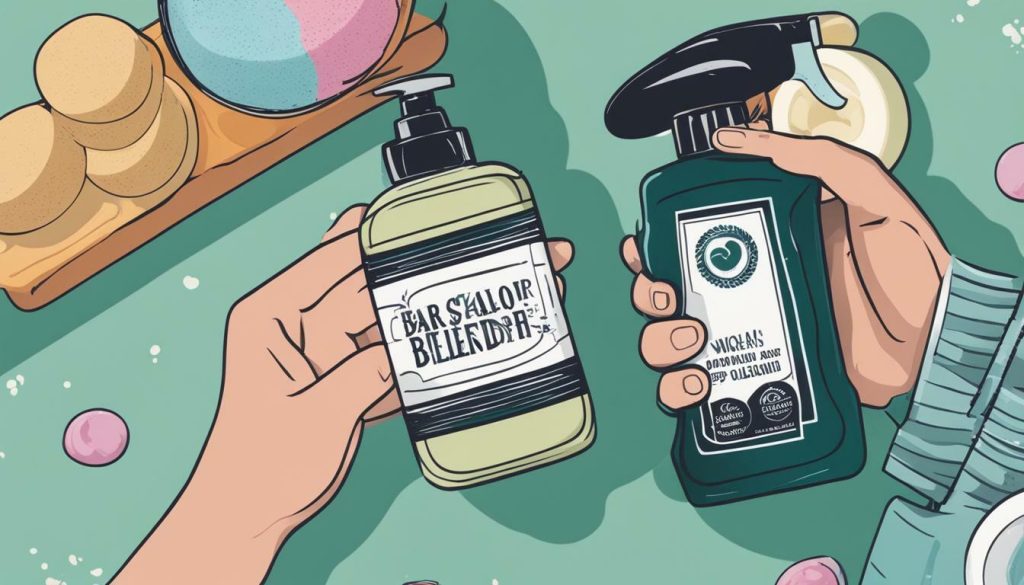If you’re looking for a unique way to reduce waste and create a personalized soap, why not try turning your liquid body wash into a solid bar soap? With just a few supplies, you can transform your shower essential into a luxurious soap that suits your unique preferences.
In this guide, we will take you through the step-by-step process of turning body wash into bar soap. From understanding the chemistry of soap making to customizing your bar soap, we’ve got you covered. So, let’s get started on your DIY journey today.
- Repurpose your liquid body wash into a customized bar soap.
- Understand the basic chemistry of soap making and choose the right body wash for your soap.
- Gather the necessary supplies and calculate the amount of lye needed for your soap.
- Mix the body wash with lye, customize your soap, and pour and cure it.
- Test and store your bar soap and troubleshoot any common issues you may encounter.
Understanding the Chemistry of Soap Making
Before you begin the process of turning your body wash into bar soap, it’s important to have a basic understanding of the chemistry behind soap making. Soap is created through a chemical reaction called saponification, which involves a combination of fats or oils with an alkali, such as lye.
The saponification process breaks down the fats or oils into fatty acids and glycerin, and the lye reacts with the fatty acids to form soap molecules. The soap molecules have a hydrophilic (water-attracting) head and a hydrophobic (water-repelling) tail that allows the soap to attach to dirt and oil on the skin’s surface and wash it away.
Understanding the soap making chemistry is crucial to ensure the safety and effectiveness of your soap. Lye is a caustic substance that can cause severe burns and injuries if not handled properly. It’s important to follow all safety precautions, such as using protective gear and working in a well-ventilated area, when handling lye.
The amount and type of oils used in the soap making process can also affect the soap’s properties, such as its cleansing power, lather, and moisturizing abilities. Consider experimenting with different oils and additives to create a soap that meets your unique needs and preferences.
Before we dive into the process, let’s go over the basic chemistry behind soap making. Soap is created through a chemical reaction called saponification, which involves a combination of fats or oils with an alkali, such as lye.
The saponification process breaks down the fats or oils into fatty acids and glycerin, and the lye reacts with the fatty acids to form soap molecules. The soap molecules have a hydrophilic (water-attracting) head and a hydrophobic (water-repelling) tail that allows the soap to attach to dirt and oil on the skin’s surface and wash it away.
Understanding the chemistry of soap making is crucial to ensure the effectiveness and safety of your soap. Lye is a highly caustic substance that can cause severe burns and injuries if not handled properly. It’s important to follow all safety precautions and use protective gear when working with lye, such as gloves, goggles, and a mask.
The type and amount of oils used in the soap making process can also affect the soap’s properties, such as its cleansing power, lather, and moisturizing abilities. Consider experimenting with different oils and additives to create a soap that meets your unique needs and preferences.
Choosing the Right Body Wash
Not all body washes are suitable for turning into bar soap. When selecting a body wash, opt for products that have natural ingredients and a high oil concentration. Avoid ones with added thickeners or surfactants, as they can affect the soap-making process and hinder saponification. Additionally, look for body washes that are free from synthetic fragrances or dyes for a more natural soap product.
In addition to the ingredients, consider the pH level of the body wash. The optimal pH for soap making is 9-10, which is alkaline. Most body washes have a pH level around 5.5, which is acidic, and can interfere with the saponification process. Look for body washes with a pH level of 9-10 or adjust the pH level using citric acid or baking soda.
Before you can begin the process of turning your body wash into bar soap, you’ll need to gather the necessary supplies. These include a heat-safe container, a soap mold, a stirring utensil, a thermometer, lye, and any additional oils or additives you desire. It’s important to use heat-resistant gloves and eye protection when working with lye to avoid any potential harm.
When selecting your heat-safe container and soap mold, choose materials that can withstand high heat and won’t react with lye, such as stainless steel or silicone. A kitchen thermometer will help you monitor the temperature during the soap-making process, while a stirring utensil, such as a wooden spoon, will help you mix the body wash and lye.
If you’ve never worked with lye before, it’s essential to take the necessary precautions to ensure your safety. Consider wearing long sleeves, pants, and closed-toe shoes to protect your skin from any potential splashes. It’s also important to work in a well-ventilated area to avoid inhaling any fumes that may be released during the mixing process.
Calculating the Amount of Lye Needed
Before you mix the body wash with lye, you must determine the right amount of lye needed for your recipe. The correct amount of lye ensures a safe and effective bar soap. Use a lye calculator to estimate the amount of lye needed based on the specific body wash you’re using and the qualities you desire in your soap. You’ll need to input the weight or volume of your body wash, the desired superfat percentage, and the type of lye you plan to use.
Lye can be hazardous if handled incorrectly, so take necessary safety precautions, including protective gloves and eyewear. Make sure to follow the instructions on the lye calculator carefully. Once you have your calculated amount of lye, measure it precisely and set it aside for the next step.
Preparing the Body Wash for Soap Making
Before you begin the soap-making process, you need to prepare your body wash. Most body washes contain thickeners and other additives that can interfere with the saponification process. To dilute your body wash, you will need to use distilled water and adjust the pH level if necessary.
Start by measuring out the amount of body wash you will need based on the lye calculator’s instructions. Then, transfer it to a heat-resistant container. For every 8 ounces of body wash, add 2 ounces of distilled water. Mix thoroughly until the body wash and water are fully combined. Adding water will help to ensure that the soap mixture is not too thick, which can make it difficult to pour into the soap mold.
If the pH level of your body wash is not within the ideal range (around 9-10), you may need to adjust it by adding a small amount of citric acid. This will help the saponification process occur more efficiently and result in a better-quality bar of soap. Simply dissolve a small amount of citric acid (around ½ to 1 teaspoon) in a separate container of distilled water, then add it to the body wash mixture, stirring well.
Be sure to wear gloves and eye protection at all times when handling lye and other soap-making supplies. Work in a well-ventilated area to minimize fumes and always follow safety best practices.
Mixing the Body Wash with Lye
Now that you’ve prepared the body wash and measured the correct amount of lye, it’s time to mix them together. This step requires caution and safety measures, as lye is a hazardous substance that can cause burns and release harmful fumes.
Wearing protective gloves and eye goggles, slowly add the lye to the body wash while stirring continuously. Be sure to pour the lye into the body wash, not the other way around, to prevent splashing. Use a heat-safe container and stir with a non-reactive utensil, such as silicone or stainless steel.
The mixture may generate heat and emit fumes, so work in a well-ventilated area and avoid inhaling the vapors. If necessary, wear a mask or respirator to protect your airways. Keep pets and children away from the area.
Continue stirring until the mixture reaches a thick, pudding-like consistency. This stage is called “trace” and indicates that the saponification process is in progress.
If the mixture is too thick or difficult to stir, add a small amount of water or more body wash to loosen it up. If it’s too thin or runny, you may have used too much water or lye.
Be sure to follow the lye calculator or recipe instructions carefully to avoid using too much or too little lye, which can affect the quality and safety of your soap.
Customizing Your Bar Soap
One of the best things about turning body wash into bar soap is the ability to create a unique soap that suits your preferences. You can customize your soap according to your skin type, scent preferences, and even texture. Here are some tips for customizing your soap:
- Add essential oils: Essential oils not only add fragrance to your soap but also provide various benefits for your skin. Consider adding lavender oil to soothe and calm the skin, peppermint oil to invigorate and refresh, or tea tree oil to help with acne-prone skin.
- Include herbs: Herbs such as chamomile, calendula, or rosemary make great additions to your soap. They can help with inflammation, soothe the skin, and provide a natural color to your soap.
- Use exfoliating agents: If you prefer a more textured soap, consider adding exfoliating agents such as oatmeal, ground coffee, or sea salt. These will help slough off dead skin cells and leave your skin feeling soft and smooth.
- Experiment with colors: You can use natural colorants such as beetroot powder, spirulina, or clay to add color to your soap. These will not only provide a beautiful hue but also have added benefits for your skin.
Remember to start with a small amount of additives and gradually increase until you achieve your desired result. Be creative and have fun with your soap-making process!
After the soap mixture has reached a thick, pudding-like consistency, it’s time to pour it into a soap mold of your choice. You can use a variety of molds, including silicone, plastic, or even recycled containers such as milk cartons.
Once you’ve poured the soap, tap the mold gently on a flat surface to remove any air bubbles and smooth out the surface. Let the soap sit undisturbed in the mold for 24-48 hours.
After 24-48 hours, check if the soap has hardened. If so, remove it from the mold and slice it into bars. If the soap is still soft, let it cure for a few more days until it’s firm enough to slice.
Once sliced, it’s time to cure the soap. Place the bars on a drying rack or a flat surface in a cool, dry place with good ventilation. Allow the soap to cure for several weeks, turning it occasionally to ensure even drying.
Curing allows the saponification process to complete, resulting in a milder and longer-lasting bar soap. It also allows any excess water or lye to evaporate, resulting in a harder and more solid bar of soap.
Testing and Storing Your Bar Soap
Now that your DIY bar soap has cured, it’s time to test it out and ensure it meets your expectations. Start by washing your hands thoroughly with the soap to get a sense of its cleansing and moisturizing properties. If you’re satisfied with the results, congratulate yourself on a job well done!
Proper storage is essential to prolonging the lifespan of your bar soap. Store it in a dry, well-ventilated area away from direct sunlight. Using a soap dish or container that allows the soap to dry between uses can help prevent premature melting or deterioration.
With the right care, your homemade soap can continue to deliver a nourishing and aromatic shower experience for weeks to come.
Troubleshooting Common Issues
Despite careful preparation, soap making can sometimes produce unexpected results. To troubleshoot common issues when turning body wash into bar soap, consider the following suggestions:
Separation
If the soap mixture separates or has pockets of oil, it may indicate that there is too much oil or that the recipe needs to be adjusted. To fix this, try increasing the amount of lye or reducing the amount of oil in the recipe. Additionally, make sure to stir the mixture thoroughly and keep it at a consistent temperature.
Soft Soap
If the soap is too soft or sticky, it may indicate that the soap has not fully cured or that too much water was added during the preparation process. Ensure that the soap is adequately cured by letting it sit for several weeks in a cool, dry area. If the soap still feels soft, try reducing the amount of water in the recipe or using less oil.
If the soap has an unpleasant odor, it may indicate that the oils used are rancid or that the soap has not fully cured. Ensure that the oils used are fresh and avoid any oils that have gone bad. Additionally, let the soap cure for several weeks before using it, as this will allow the soap to fully develop its scent.
By troubleshooting common issues, you can refine your soap-making skills and create high-quality bar soap that suits your preferences. Don’t be discouraged by challenges; instead, use them as an opportunity to learn and improve.
Conclusion
Turning your body wash into bar soap is a fun and eco-friendly DIY project that allows you to take control of your skincare routine. By understanding the chemistry of soap making, choosing the right body wash, and gathering the necessary supplies, you can create a personalized bar soap that suits your unique needs and preferences. Remember to use caution and follow safety guidelines when working with lye.
Start Your Soap-Making Journey Today
Whether you’re an experienced soap maker or a beginner, this guide offers a step-by-step process to transform your liquid body wash into a solid bar soap. Customizing your soap with essential oils, herbs, or exfoliating agents allows you to create a soap that caters to your skin’s needs. After curing, test your soap’s cleansing and moisturizing properties, and store it in a dry, well-ventilated area. Troubleshoot any issues along the way, and don’t get discouraged. Happy soap-making!

Hey there! I’m Dr. Mary Noland, your trusted authority in dermatology. My 17-year rollercoaster ride in skin science has been nothing short of a masterclass. Whether you’re a newbie or a familiar face, I’m here with open arms and Medicare-friendly services, dedicated to creating your perfect skin haven.
But hold up! There’s more to me. When I’m not elbow-deep in dermatology, I’m lighting up derma blogs with insights that peel back the layers of skin health. Also, as the proud captain of ‘buybodywash.com‘, I provide all the body care goodness you need!
Trust me; I’m more than just a white coat. I’m here to lend an ear, share a laugh, and bring calm with a reassuring voice that’s comforted countless patients.
So, meet Dr. Mary Noland – your dermatologist and your guide and friend on the path to radiant skin. I am excited to meet you soon!

